Configuring the eG Agent to Monitor Microsoft Azure Active Directory
To enable the eG agent to monitor Azure AD, you need to perform the following broad steps:
-
Register an Application with an Azure AD Tenant;
-
Determine the Tenant ID, the Application (Client) ID and Secret Key value associated with the registered Application;
-
Assign API permissions to the registered Application;
-
Assign the Application to a Subscription and grant 'monitoring' rights to it
The sub-sections below discuss each of these steps in detail.
Registering an Application with Azure Active Directory (AD)
An Azure AD Application is a digital identity and some associated configuration, which informs Azure AD about how to treat software which uses that digital identity.
The eG agent can pull performance metrics related to an Azure tenant, its services, and its resources, only if it communicates with an Azure AD tenant as an 'Application' with 'monitoring rights'.
If such an Application pre-exists with the target tenant, then you can configure the eG agent with the access credentials of that application. However, if no such application pre-exists, then first register a new Application with Azure AD and obtain the access tokens that Azure AD issues for that application.
To achieve this, do the following:
-
Login to Microsoft Azure portal using https://portal.azure.com with valid credentials.
-
Click on the Azure Active Directory indicated by Figure 280.

-
When Figure 281 appears, click on the App Registrations option in its left pane.

-
Figure 282 will then appear.

-
To register a new application, click the New registration option indicated by Figure 282. The Register an application page will then appear as shown by Figure 283.

-
In Figure 283, specify the following:
- The name of the application in the Name text box,
-
Select the type of the account from the Supported account types section.
Supported account types Description Accounts in this organizational directory only
Select this option if you want all user and guest accounts in your directory to use the application or API.
Use this option if your target audience is internal to your organization.
Accounts in any organizational directory
Select this option if you want all users with a work or school account from Microsoft to use this application or API. This includes schools and businesses that use Office 365.
Use this option if your target audience is business or educational customers and to enable multitenancy.
Accounts in any organizational directory and personal Microsoft accounts
Select this option if you want all users with a work or school, or personal Microsoft account to use your application or API. It includes schools and businesses that use Office 365 as well as personal accounts that are used to sign in to services like Xbox and Skype.
Use this option to target the widest set of Microsoft identities and to enable multitenancy.
Personal Microsoft Accounts only
Select this option if you want the application or API to be used by only those users with personal accounts that are used to sign in to services like Xbox and Skype.
- Then, enter the redirect URl (or reply URL) for your application in the Redirect URl text box. Typically, you need to provide the base URL of your app. For example, http://localhost:31544 might be the URL for a web app running on your local machine. Users would use this URL to sign in to a web client application. For public client applications, provide the URL used by Azure AD to return token responses. Enter a value specific to your application, such as https://DocApp.com//auth.
-
Clicking the Register button in Figure 283 will create the Application. Then, Figure 284 will appear displaying the Essentials related to the new Application.

-
From the Essentials, you can obtain the Application ID and Directory ID (see Figure 284). Copy the Application ID and the Directory ID and paste them against the Client ID and TENANT ID text boxes while configuring eG tests for the target Azure component.
Obtaining the Client Secret
For the eG agent to obtain metrics from the target Microsoft Azure component, it is necessary to provide the client secret associated with the registered Application. For this, click on the Certificates & secrets option in the left pane of Figure 284. This will invoke Figure 285.

Figure 285 : Creating New Client Secret
Clicking on the New client secret button in the right panel of Figure 285 will invoke Figure 286. Specify the description of the client secret in the Description text box and choose an expiry period from the Expires section as shown in Figure 286.

Figure 286 : Adding the client secret
Clicking the Add button in Figure 286 will display a client secret value in the Value column of Figure 287.

Figure 287 : Generating the client secret value for the application
Note that the Value will disappear once you leave this page, so make sure that you copy the new client secret value in the clipboard by clicking the ![]() icon. Otherwise, you may need to generate a new client secret value. The client secret value has to be specified against the Client password field in the test configuration page.
icon. Otherwise, you may need to generate a new client secret value. The client secret value has to be specified against the Client password field in the test configuration page.
Assigning API Permissions to the Registered Application
As already mentioned, the eG agent connects to Azure AD as a registered Application, makes Java API calls, and collects metrics from it. Most commonly, the eG agent uses the Microsoft Graph API for metrics collection. To enable this API to pull metrics, you need to grant different 'read' permissions to that API. For granting these permissions to the Microsoft Graph API for the registered Application, do the following:
-
In Figure 287 above, click on the API Permissions option in the left pane. Figure 288 will then appear.

-
As you can see, the registered Application has by default being assigned a Delegated permission; this is the User:Read permission for Microsoft Graph API. Since this permission is not required for monitoring purposes, let us proceed to remove it. For that, first, right-click on the permission listed in the right pane of Figure 288, and select the Remove permission option from the menu that pops out (see Figure 289).

-
A message box will then appear requesting you to confirm the deletion of the default permission. Click on the Yes, remove button in Figure 290 to delete the chosen permission.

Figure 290 : Confirming the deletion of the default permission
-
Next, proceed to assign permissions that the Application needs for pulling metrics from Azure. For this, first click on the Add a permission button in the right pane of Figure 289. Figure 291 will then appear. Click on the Microsoft Graph option in Figure 291 to set permissions for the Microsoft Graph API.

-
Figure 292 will then appear, where you will have to choose the type of permissions you want to add to the API. Click on the Application permissions option in Figure 292.

-
Using Figure 293 that then appears, select the permission that you want to grant to the API. For this, type the text 'user' in the Search text box under Select permissions. Permission groups with names containing the typed text will then be listed hereunder. Keep scrolling down the list of permission groups until the User group becomes visible.

Figure 293 : Searching for the permission groups with names containing the text 'user'
-
Once you find the User group, expand it by clicking on the 'arrow' prefixing it. The individual User permissions will be listed therein. Select the User.Read.All permission by clicking on the check box corresponding to it (see Figure 294). Then, click on the Add permission button in Figure 294 to assign that permission to the API.

Figure 294 : Assigning the User.Read.All permission to the API
-
Figure 295 will then appear displaying the permission that you just assigned.

Figure 295 : A page displaying the User.Read.All permission assigned to the Microsoft Graph API
-
Next, click on the Grant admin consent for Default Directory button in Figure 295. Figure 296 will appear. Click on the Yes button in Figure 17 to grant consent for the User.Read.All permission for all accounts in Default Directory.

Figure 296 : Granting consent for the User.Read.All permission for all accounts in Default Directory
-
The User.Read.All permission listing will then change as depicted by Figure 297.

Figure 297 : The User.Read.All permission listing after granting admin consent
-
Next, using step 4 - 10 above, add the following 'read' permissions as well to the Microsoft Graph API for the registered Application:
-
Group.Read.All
-
Directory.Read.All
-
AuditLog.Read.All
-
Device.Read.All
-
Application.Read.All
Refer to Figure 298, Figure 299, Figure 300, Figure 301, and Figure 302 to more clearly understand how to assign each of the above permissions.

Figure 298 : Assigning the Group.Read.All permission

Figure 299 : Assigning the Directory.Read.All permission

Figure 300 : Assigning the AuditLog.Read.All permission

Figure 301 : Assigning the Device.Read.All permission

Figure 302 : Assigning the Application.Read.All permission
Also, note that after adding each permission, you have to click on the Grant admin consent for Default Directory button (like the one you see in Figure 295) to grant consent for that permission for all accounts in the Default Directory.
-
-
Once all the permissions are assigned and the admin consent is granted for each permission, Figure 303 will appear.

Figure 303 : A page displaying all the 'read' permissions assigned to the Microsoft Graph API for the registered Application
-
In Figure 303 above, click on the API Permissions option in the left panel. Figure 304 will then appear. Now, using Figure 304, proceed to assign permissions that the application needs for pulling metrics from Azure. For this, first click on the Add a permission button in the right panel of Figure 304.
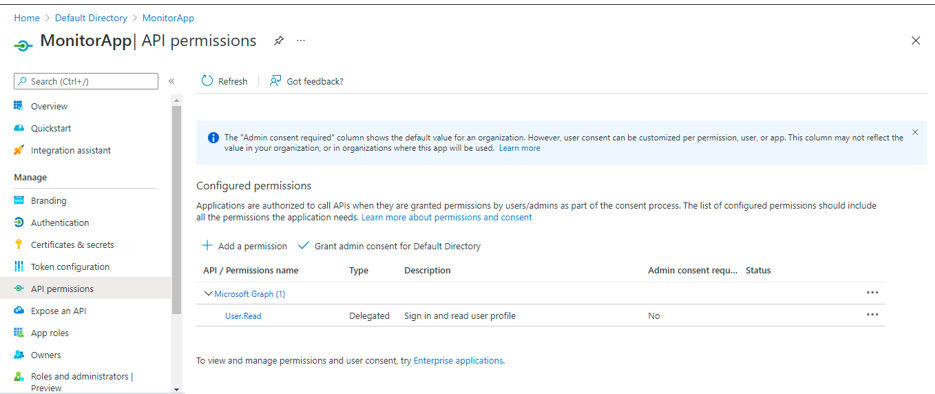
Figure 304 : Clicking on Add a permission button to add more API permissions to the application
-
Figure 305 will then appear. Click on the APIs my organization uses tab and type Log Analytics API in the Search text box. The API you are searching for will then be displayed in the result set (see Figure 305). Click on the Log Analytics API that is listed inFigure 305.
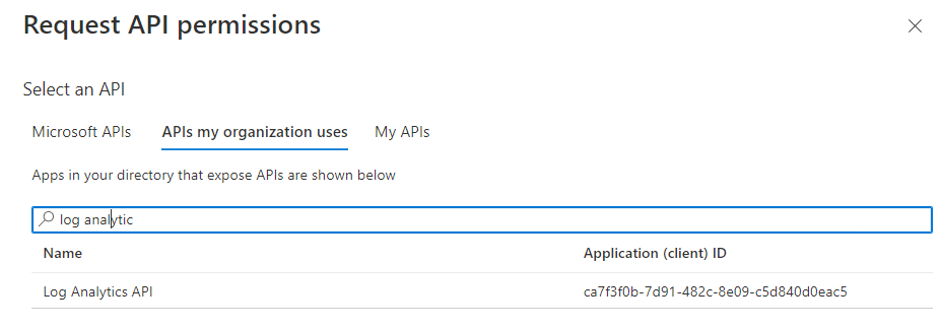
-
Figure 306 will then appear. Click on Application permissions in Figure 306. Then, browse the Select permissions list in Figure 306 until you locate the Data permission. Click on the arrow pre-fixing the Data permission, so that you can view the sub-permissions within. From the list of Data permissions, select the Data.Read permission by clicking on the check box corresponding to it (see Figure 306). Then, click on the Add permissions button in Figure 306 to assign that permission to the API.
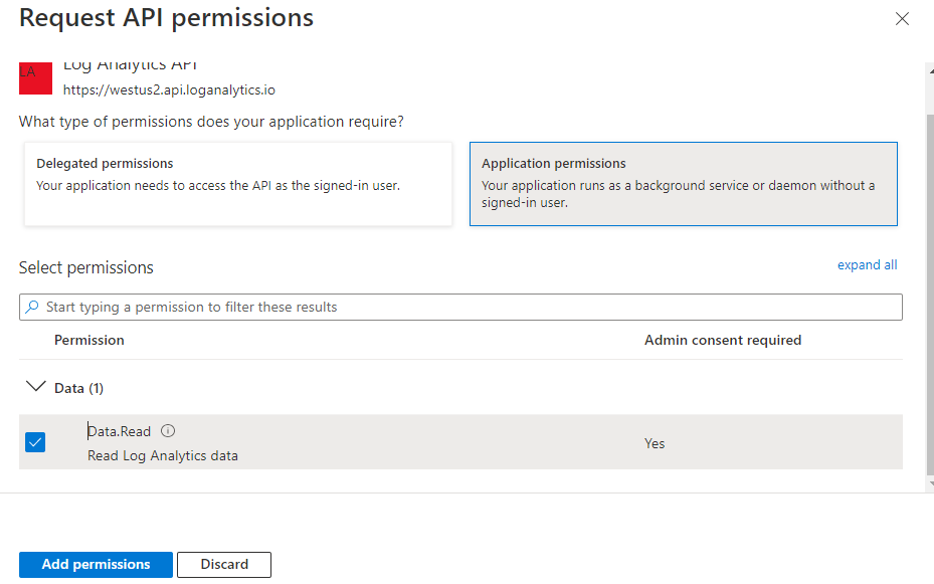
Figure 306 : Assigning the Data.Read permission to the Log Reader Analytics API
-
Also, note that after adding each permission, you have to click on the Grant admin consent for Default Directory button (like the one you see in Figure 295) to grant consent for that permission for all accounts in the Default Directory.
Assigning the Application to a Subscription and Granting Monitoring Rights
Once the application is created, you need to grant that application monitoring access to all the resources contained with a specific subscription. To achieve this, do the following:
-
In the Azure console, click on the Subscriptions option indicated by Figure 307.

-
When Figure 308 appears, select the subscription that you want to access by clicking on it.

-
Figure 309 will then appear. Click the Access Control (IAM) option in the left panel of Figure 309.

-
The right panel will then change to display a Check Access section (see Figure 310). To grant monitoring rights for resources contained within a subscription, you need to create a new role. For that, click on the Add role assignment button in Figure 310.

-
Figure 311 will then appear. Now, keep scrolling down the list of roles in Figure 311 until you find the Monitoring Reader role (see Figure 312). Select that role by clicking on it, and then click the Next button in Figure 312.

Figure 311 : Scrolling down the list of roles that pre-exist

-
Figure 313 will then appear. Here, indicate which resource in the chosen subscription should be assigned the chosen role. For that, choose to Assign access to a User, group, or service principal, and then proceed to click on Select members.

-
Figure 314 will then appear. Using the Select members dialog box depicted by Figure 314, you have to select the application to which you want to assign the Monitoring Reader role. This should be the new application you previously registered with Azure AD. To search for this application, in the Select text box of Figure 314, enter the name of the application. Once the application is found, its name will appear below the Select text box. To select that application, click on it and then click on the Select button in Figure 314.

Figure 314 : Selecting the applicaton registered with Azure AD
-
Figure 315 will then appear, where your selection will be displayed. Click on the Next button in Figure 315 to continue.

Figure 315 : A page indicating that the Monitoring Reader role has been assigned to the selected AD application
-
This will invoke Figure 316. Quickly review the role assignment using Figure 316, and then click the Review + assign button to complete the process.

Figure 316 : Review and assign the role to the chosen application
-
Next, using steps 4 - 9 above, assign the following roles to the registered application (see Figure 317, Figure 318, and Figure 319):
-
Storage Account key Operator Service Role
-
Billing Reader
-
Log Analytic Reader
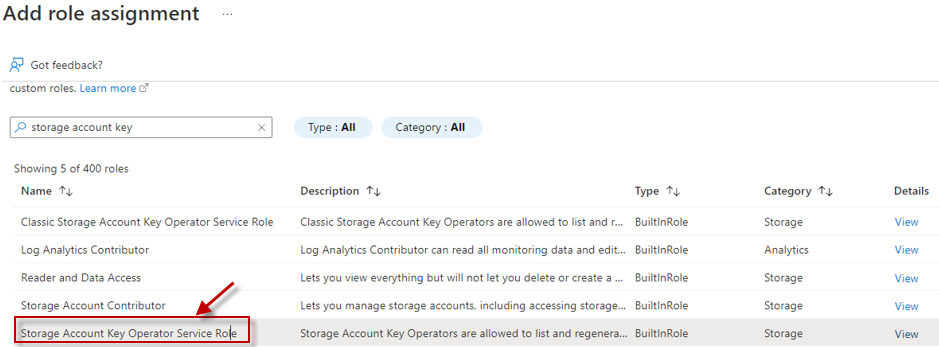
Figure 317 : Assigning Storage Account Key Operator Service Role
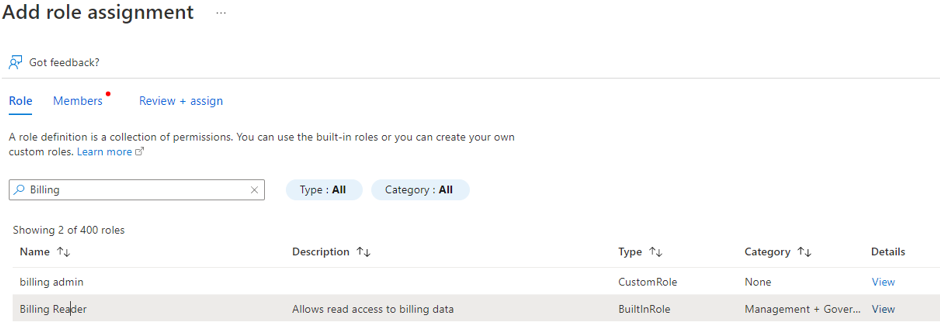
Figure 318 : Assigning Billing Reader Role
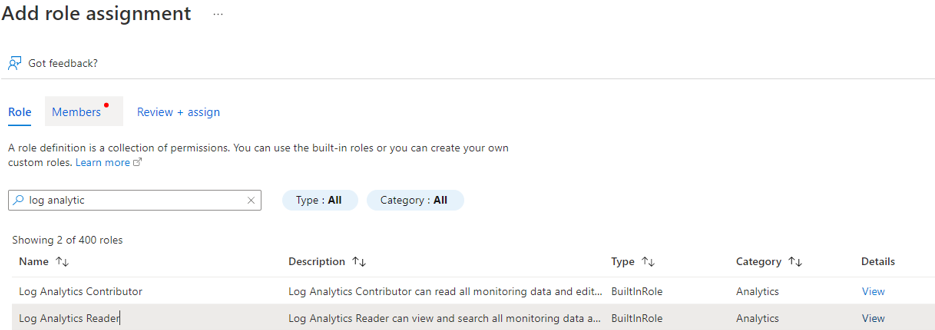
-
